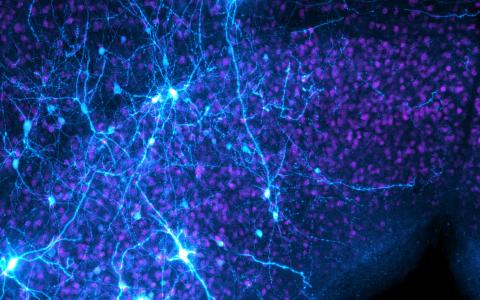
Newly Discovered ‘Shelter-Direction Cells’ Unlock the Mysteries of Escape
In a study conducted by Ruben Vale and Dario Campagner along with colleagues in the Branco and Margrie Labs at the Sainsbury Wellcome Centre, scientists have uncovered a neural circuit that encodes the direction of safe places in the environment. Their manuscript, “A cortico-collicular circuit for orientation to shelter during escape” investigates how the defensive system accesses spatial memory, a process that previous work on escape behaviour has identified but not explored fully.
When faced with a threat, many animal species escape directly towards shelter—defined as a location in the environment the animal has learned is safe through exploration. Scientists have understood that this process relies on spatial memory, but the mechanics of it have not been well understood until now. Through recording brain activity in naturally behaving mice, researchers at the SWC found a new cell type that continuously encodes the direction of a sheltering location in relation to where the animal is within its environment. This information is key to the animal’s ability to accurately head to shelter.
The researchers found these so-called ‘shelter-direction cells’ in areas of the brain known to control directional motor actions and integrate visual and spatial information—the superior colliculus (SC) and retrosplenial cortex (RSP), respectively. Moreover, they showed that a pathway between RSP and SC directly transfers spatial information from the cortex to the midbrain, and that this information is specifically related to defensive shelter-seeking: When they deactivated the connection between the two brain regions in the lab, the animal was still able to orient to sensory clues but was not able to escape when faced with an artificial threat.
These results lead to a model whereby the RSP continuously computes the direction towards shelter in relation to the animal’s location and transmits this information downstream to the SC, which then integrates it with evidence of threat to generate shelter-directed escapes at the appropriate time.
This research contributes to a growing body of evidence (including some from earlier work in the Branco Lab) that the midbrain is a fundamental hub for processing threat information and controlling defensive behaviours. By showing how the midbrain accesses information about the space around the animal, this paper provides an important piece of the puzzle of identifying circuit elements and mechanisms of escape.
This study not only shows how spatial information is used to generate defensive behaviour, it also contributes some important data to our broader understanding of the brain. The discovery of shelter-direction cells provides an entry point for understanding how goal-directed actions in general integrate spatial information. This mechanism has remained a mystery despite 40 years of research on navigation in mammals.
In addition, this research indicates the neocortex plays a much more active role in escape behaviour than previously thought. Animals have been escaping from threats for at least 500 million years, but the neocortex only evolved about 200 million years ago. This means in theory an animal doesn’t need a neocortex to escape from a threat. The finding that rodents—and perhaps all mammals—use the neocortex during escape behaviour may indicate that the brain region allows animals to escaping to shelter rather than merely distancing oneself from the threat, as our pre-neocortex ancestors did.
This paper has been submitted for peer review. Read the full preprint on BioRxiv Here: “A cortico-collicular circuit for accurate orientation to shelter during escape”.
